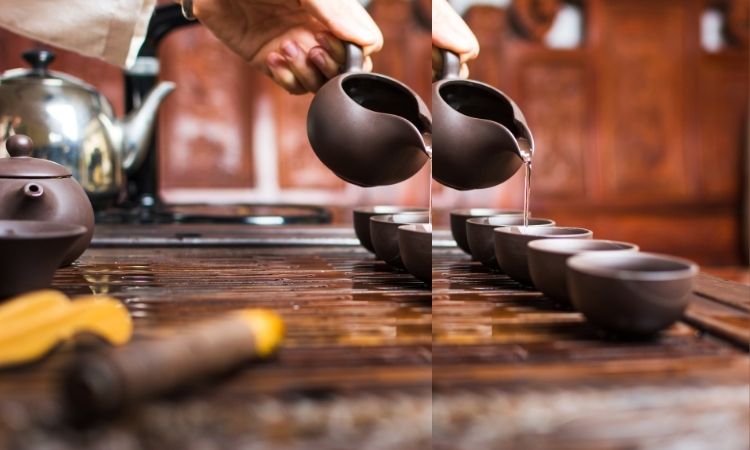I’m in love with Chinese tea. I drink it all day long, and each time I go home to Europe, I give beautiful tea boxes to my friends and family. In addition, I purchase tons of tea.
My most loved Chinese tea is Long Jing, a green tea grown close to the West Lake of Hangzhou. I also love flower tea and Pu’er, the fermented tea made in Yunnan Province.
If you perform an initial search on the internet, you’ll find a wealth of information on Chinese tea.
I chose to limit this first piece on Chinese tea to two subjects that I find interesting—the various classes of Chinese tea and the most well-known tea brands.
For instance, there is one called the Long Jing green tea from Hangzhou and Tai Hu’s Bi Luo Chun green tea from Tai Hu, and so on).
The various classes of Chinese tea
Chinese Green Tea
Green tea is one of the most natural teas of all Chinese teas. This is because it’s dried right after it’s picked out of the field, then cooked. But, unfortunately, this procedure blocks the action of the leaf enzymes, which might alter the composition and characteristics of tea leaves.
Evidence has demonstrated that regular consumption of green tea could help prevent cardiovascular diseases such as obesity, cancer, and diabetes.
Even tho it’s healthier than black and coffee tea, some people struggle to transition from these drinks, which are more prevalent in the West, to green tea, a beverage with a distinct flavor.
My opinion is that it’s all about habits once you’ve switched and started drinking green tea more than black coffee.
In China, eight different varieties of green tea are prevalent both domestically and internationally. A few of these teas are:
Biluochun The leaves curl like snails. The tea is made in the province of Jiangsu. In Jiangsu province.
Chun Mee Tea is most well-known in China as it has a flavor like plum.
Longjing Tea: This tea is among the most sought-after and comes from Hangzhou, the most renowned city in Zhejiang province.
Oolong Tea Chinese Oolong Tea
It is described as partially fermented (or semi-oxidized), and in this way, it is a middle ground between black and green tea. Tea leaves from Oolong tend to be green toward the middle but change to red near the edges. The leaves’ hue changes because the tea is cooked, rolled, and roasted.
Although its flavor is relatively mild, don’t consume too much tea oolong since it’s more potent than it appears!
Oolong tea is believed to give bone, brain, and heart benefits when consumed often. The tea’s production is mainly located within two Chinese regions: Anxi County and the Wuyi Mountains. Both have been producing oolong tea for quite a while.
Oolong tea is usually distinguished by its ball-shaped crumbled shape when dried. In contrast, many of the green teas don’t possess this form.
Chinese Black Tea
Black tea, often known as “red tea” in China, is dried, oxidized, and roasted. It is more acidic than green, white, and oolong teas. It’s more flavorful and generally higher in caffeine than other classes in tea.
Green tea has a taste that fades after an entire year; the flavor of black tea could last for a long time. This is why it has been traded with Europe for many centuries.
It’s believed the consumption of black tea can offer benefits, such as improving the health of your heart, reducing bad cholesterol, lowering the levels of blood sugar, reducing the risk of getting cancer, and much more. Although most teas appear to provide benefits for health, you must be aware of which tea you find most appealing.
Chinese White Tea
White Chinese tea goes through the same process as green tea. However, because it has anti-oxidation qualities, it’s considered one of the healthiest varieties of tea.
The white color is derived from hairs present on buds that have not yet opened on the plant. Therefore, even though the tradition of producing white tea is long-standing, the variety that we have here is scarce, and, in the past, only the emperors and their crew could take pleasure in the benefits.
White tea is said to shield teeth from bacteria, delay the aging of the skin, reduce the risk of heart-related diseases, aid with weight loss, and is loaded with antioxidants. There are a variety of white teas to choose from, including White Peony, Silver Needle, Moonlight White, and many more.
Chinese Yellow Tea
The procedure for getting the yellow tea is the same as for making green and white tea. The difference is due to the reason that the tea leaves are dried for longer to make them yellow. It’s an oxidized tea that is mild. Based on the opinions of some specialists, yellow tea could be superior to green tea.
It is believed that tea with a yellow hue can boost mental well-being and reduce the risk of strokes and lower cholesterol levels, improve the bones and teeth of your mouth, and ensure that your arteries are healthy. It is referred to in the Chinese language as “Huang Cha” by the Chinese. The tea comes from various provinces and cities, such as Hunan, Anhui, Sichuan, Zhejiang, Hubei, and Guizhou.
Chinese Flower Tea:
This type of tea can be subdivided into flower or scented teas. The flower tea comprises dried flowers, such as jasmine, hibiscus, chrysanthemum, globe amaranth, and lily. Scented tea is an assortment of tea leaves wrapped with dried flowers.
Flower teas are typically sourced in the Yunnan province, located in the southwestern regions of China. The well-known benefits of drinking tea with flowers include easing anxiety and stress, better digestion, anti-aging, and having healthier hair.
Pu’er Tea
Pu’er tea (also called Pu-erh)
This tea, known as Pu’er, is a fermented, oxidized tea produced within Yunnan province. The leaves are fermented after drying and then wrapped. The tea is then made into confections that remind you of a bun or small cake.
This tea should be stored in close contact with the air to ensure fermentation. Like wine, the value of Pu’er tea has increased over time.
Although it’s usually considered black tea, a distinctive pu’er merits its category.
The difference between “oxidation” and “fermentation” can be seen in the fact that, whereas oxidation is an unintentional chemical reaction, the fermentation process is caused by microorganisms.

The top 10 well-known Chinese teas
Long Jing
The Jing ( Chinese word that means “Dragon Well”). It is an assortment of pan-fried green tea from the Xi Hu (West Lake) district in Hangzhou, located within Zhejiang Province. It’s my favorite tea.
Long Jing is commonly known as top quality and is also a part of its own famous China Tea title. It contains everything from amino acids to Vitamin C and contains the highest catechins. Both have an impact on how the tea tastes and how it feels. In addition, Long Jing tea is relatively cheap, and many people take it every day.
Bi Luo Chun
Bi Luo Chun Bi Luo Chun (Bi Luo Chun, Spring Snail) is also a green tea that comes from Tai Hu in Jiangsu Province.
Bi Luo Chun is another well-known green tea that is considered the top tea by experts. It has a long tradition throughout the world. It is split into seven distinct qualitative classes. So this is sort of self-explanatory as to how popular the tea is.
Tie Guan Yin
Tie Guan Yin Tie Guan Yin (Tie Guan Yin, Iron Goddess) is an oolong tea from Anxi, located in Fujian Province.
Tie Guan Yin is a tea that dates back to the 18th century and goes by numerous other names, such as Ti Kuan Yin, Iron Guanyin, or Tiet Kwun Yum. The best Tie Guan Yin teas can sell for some of the most expensive prices around the globe. Recently, it was reported that 1 kilogram of premium Tie Guan Yin tea was sold for up to USD 3,000 per kilogram, which is astonishing.
Mao Feng
Mao Feng Mao Feng (Mao Feng, Fur Peak) is a green tea originating from Huang Shan, the Yellow Mountain in Anhui Province.
Mao Feng is among the most well-known tea varieties in China and is included in the China Famous Tea list. The tea is scented with spring-like foliage, has bright notes, and is high in levels of antioxidants.
Yin Zhen
It is known as Yin Zhen (Yin Zhen, Silver Needle) and is a yellow tea that comes from Jun Mountain and Dongting Lake, located within Hunan Province.
Yin Zhen tea is the most expensive Chinese white tea, as only the uppermost parts of the plants are used to make the tea. China began exporting tea in the 1800s. The mother tree is located at Hongxue Cave, Taimu Mountain.
Qi Men Hong Cha
Qi Men Hong Cha Qi Men Hong Cha (Qi Men Hong Cha, Qimen Red Tea) is a black tea made in Qimen County, located within the Anhui Province.
In English, the tea is known as Keemun Tea and is among the most popular black teas in China. It is said to have the sweet smell of roses and honey.
Da Hong Pao
Da Hong Pao (Da Hong Pao, Big Red Robe) is an oolong tea originating from Wiyi Mountain, on the Fujian and Jiangxi Province boundary.
The tea is distinguished because it is packed in large, red containers bearing the character “Da Hong Pao.” As per the BBC, Da Hong Pao is among the teas that cost the most, and in 2002, a Chinese person purchased 20g of it for about USD 28,000.
Gua Pian
Gua Pian (Gua Pian, Gua Pian) is a green tea made in Lu’An, Anhui Province.
It is generally called Lu’An Gua Pian, which refers to melon seeds, because the leaves are designed to resemble self-fermented melon. The first tea was described in the renowned book, The Classic of Tea.
Bai Hao Yin Zhen
Bai Hao Yin Zhen (Bai Hao Yin Zhen Silver Fur White Needle) is a white tea from Fu Ding in Fujian Province.
As we’ve mentioned, it can be the most expensive white tea available in China. Three steps produce it:
1. hand-picked
2. Syn-drying
3. Dehydrating the tea
This last step is challenging.
Pu-Erh
It is known as Pu-erh (Pu Erh, Pu’er Tea), a fermented tea post-fermented in Simao County in Yunnan Province.
Pu-erh assists with digestion and helps relax your intestines. It is known to be beneficial for people suffering from stomach problems.
Where can I purchase Chinese tea?
Finding high-quality Chinese tea at a fair price isn’t an easy task. However, after purchasing from various e-commerces, I came across teavivre as being among the top due to its offering an extensive selection of Chinese teas (including organic teas) straight from China and at a fair cost.









